Antifungal Effect of Organic Amendments on the Mycelial Growth and Sclerotia Viability of Rhizoctonia Solani Kuhn.
0 Views
- RAJESWARI1*, 2.B. PADMODAYA, 3.K. VISWANATH, 4.P. SUMATHI
1,2.Dept of Plant Pathology, S.V. Agricultural College, Tirupati, 3.Dept of Plant Pathology, IFT, RARS, Tirupati,
4.College of Agril. Engg., Madakasira, Ananthapur
ABSTRACT
A shift towards organic farming suggests the amalgamation of organic resources against soil borne plant pathogens. In the present study, efforts were made to explore the efficacy of organic amendment extracts against Rhizoctonia solani. Efficacy of six oil free cakes viz., neem, karanj, castor, groundnut, sunflower and gingelly at 5, 10 and 15 per cent concentrations were evaluated by using poisoned food technique. All the amendments tested were significantly superior to control in checking the mycelial growth of the fungus. Among the tested amendments groundnut cake showed (100 %) inhibition at 15 per cent concentration followed by neem cake (86.66 %) inhibition. The least inhibition was recorded with castor cake (44.44 %). A mong the six organic amendments tested against sclerotial viability only two viz., neem and groundnut cakes were found to be effective in inhibiting the sclerotial germination at higher incubation periods of 24 hrs. Rest of the amendments tested were ineffective in inhibiting sclerotial germination even though they were effective in inhibiting the mycelial growth. Neem cake and groundnut cake were also effective in inhibiting sclerotial germination when applied to soil.
KEY WORDS: Amendment, inhibition, Rhizoctonia solani, sclerotia
1.INTRODUCTION
The indiscriminate and disproportionate use of pesticides might lead to residues in food chain exerting harmful effects in humans and animals (Chalal et al., 2016). Hence the development of novel and safe plant protectants which interfere with the fungal pathogenecity factors is the need of the hour (Srivastava and Singh, 2011). A change in the line of research has been oriented to find out the alternate means like inclusion of organic amendment, use of plant products, natural preparations and bio-control agents including the use of agro chemicals under the umbrella of integrated disease management (IDM) to minimize the chemical load. Control of sheath blight disease through soil amendment with oil cakes has been reported by several workers (Srinivas Prasad et al., 1997; Meena and Muthuswami, 1999; Meena et al., 2000; Sarkar et al., 2000).
Hence, in the present study organic amendments viz., Neem cake, Pongamia cake, Castor cake, Gingelly cake, Sunflower cake and Groundnut cake were used to evaluate their efficacy in management of sheath blight.
2.MATERIALAND METHODS
The present experiments were carried out in the Department of Plant Pathology, S.V. Agricultural College, Tirupati
1.1. 2.1 PREPARATION OF ORGANIC AMEND- MENT EXTRACTS
For the preparation of organic amendment extracts (cold water extract), required quantity of amendment was taken and made into powder. It was soaked overnight in sterile distilled water at the rate of 1g/ml. The material was then filtered with double layered musclin cloth. This formed the standard amendment extract solution of 100 per cent concentration.
2.2 EFFECT OF ORGANIC AMENDMENTS ON T H E GROW T H OFRHIZOCTONIA SOLANI
The efficacy of each amendment was tested at three concentrations (5, 10 and 15 per cent) by poisoned food technique (Nene and Thapliyal, 1986) by measuring the radial growth of the fungus.
The Petri plate containing Potato Dextrose Agar medium inoculated with R. solani alone served as control. The Petri plates were incubated at room temperature (27±1o C). Three replications were maintained for each treatment. The fungal growth inhibition was calculated by using the formula given below by Vincent (1927)
Where, I = Per cent reduction in growth of test pathogen, C = Radial growth (cm) in control, T = Radial growth (cm) in treatments.
2.3 EFFECT OF ORGANIC AMENDMENTS ON THE SCLEROTIAL VIABILITY OF R. SOLANI IN VITRO
For each treatment, amendment solution were prepared at 5, 10 & 15 per cent concentrations given using sterile distilled water. Ten sclerotia of the test pathogen were taken for each replication and soaked in the respective amendment solution for substantiate timings (Regular interval should be there in timings) 30 min, 6 h, 18 h and 24 h. Control was maintained by soaking sclerotial bodies in distilled water. Then the sclerotia were retrieved and placed on the PDA medium for testing their viability. Per cent inhibition of sclerotial germination was calculated (Harikrishnan and Yang, 2001).
Per cent inhibition

2.4 EFFECT OF ORGANIC AMENDMENTS ON THE VIABILITY OF SCLEROTIA OF R. SOLANI MIXED IN SOIL.
Soil was collected from paddy cultivated field aand was dried and used in this experiment. Ten grams of soil was taken into plastic cups and ten sclerotia of the sheath blight pathogen were mixed with the soil. The organic amendments which were found effective in the previous experiments were chosen for evaluation of sclerotial vi- ability. The respective amendment solution was added to the plastic cup containing sclerotia and soil mixture up to saturation and incubated for 10 days. In control, distilled water was added to the plastic cup containing sclerotia and soil mixture up to saturation. After 10 days the sclero- tia were retrieved and placed on PDA medium for testing their viability. The data was analysed in CRD with SPSS statistical package.
3. RESULTS AND DISCUSSION
3.1 EFFECT OF DIFFERENT ORGANIC AMENDMENTS ON THE MYCELIAL GROWTH OF SOLANI IN VITRO.
The organic amendments viz., neem, groundnut, karanj, sunflower, gingelly and castor cakes were screened against R. solani by poisoned food technique. The data presented in Table 1 revealed that all the amendments tested at 5, 10 and 15 per cent concentrations were significantly superior to control in checking the mycelial growth of the fungus.
When five per cent concentration of different organic amendments was tested against R. solani, highest percentage inhibition (77.03%) was observed with groundnut cake followed by neem cake (68.88%), gingelly cake (53.33%), sunflower cake (52.59%), karanj cake (48.88%) and castor cake (31.85%). Groundnut cake significantly differed with all other treatments in inhibiting the radial growth (Plate 1). All the treatments were significantly superior to control.
When 10 per cent concentration of different organic amendments was tested against R. solani, highest percentage inhibition (82.96%) was observed with groundnut cake followed by neem cake (75.55%), sunflower cake (71.85%), gingelly cake (74.81%), and karanj cake (74.81%) and castor cake (36.29%).
Groundnut cake significantly differed with all other -treatments, here also. All the treatments were significantly superior to control in inhibition of radial growth.
When 15 per cent concentration of different organic amendments was tested against R. solani highest percentage inhibition (100%) was observed with groundnut cake followed by neem cake (86.66%), gingelly cake (82.96%), sunflower cake (77.03%), and karanj cake (81.48%) and castor cake (44.44%). Groundnut cake significantly differed with all other treatments. Among six organic amendments tested the highest mean percent inhibition was observed with groundnut cake at 15 per cent concentration followed by neem cake, gingelly cake, karanj cake, sunflower cake and castor cake. No sclerotial production was observed in all the treatments.
Many workers have reported that extracts of oil cakes had great impact on inhibition of the radial growth and sclerotial production of R. solani under in vitro (Lenka et al., 2014, Meena et al., 2014, Vibha, 2010, Dubey et al., 2009). Aparna and Girija (2018) reported that oil cakes of neem and groundnut evaluated by poisoned food technique exhibited the highest inhibition on radial growth of R. solani. Dubey and Patel (2000) observed maximum suppression of the pathogen with groundnut oil cake at 10 per cent concentration.
In the present study, it was observed that among oil cakes, neem and groundnut cakes showed maximum inhibition on the mycelial growth.
3.2 EFFECT OF DIFFERENT ORGANIC AMENDMENTS ON THE SCLEROTIAL VIABLITY OF R. SOLANI IN VITRO.
In order to find out the effect of organic amendments on the survival and viability of sclerotia, ten sclerotia of the fungus were taken for each replication and soaked in the respective solution for 30 min, 6 h, 18 h and 24 h. Control was maintained by soaking sclerotial bodies in distilled water. Sclerotia were retrieved and subjected to germination test on PDA. The results are presented in the Table 2.
Among all the treatments, neem cake (76.66%) and groundnut cake (73.33%) were found to be effective in inhibiting sclerotial germination at the higher incubation periodi. e. 24 h. Rest of the amendments tested were ineffective in inhibiting sclerotial germination even at the higher incubation periods though they were effective in inhibiting the mycelial growth (Plate 2, 3, 4, 5).
Inhibition of sclerotial germination and sclerotia formation by extracts of oil cakes and plant extracts was reported by Dubey et al. 2009; Lenka et al. 2014 and Kumar et al. 2017.
In the present study extracts of oil cakes at 15 per cent concentration exhibited different inhibition effects on R. solani. However, soaking of sclerotial bodies for longer period had certainly resulted in increased inhibitory effect and thus exposure of sclerotia to the extracts for longer periods may be attributed for the reduction of sclerotial viability. This is in agreement with the studies conducted by Dubey et al. 2009 on the extracts of neem cake, leaves and bark against M. phaseolina where maximum inhibition of sclerotial germination was noticed after 96 hrs of incubation
3.3 EFFECT OF DIFFERENT ORGANIX AMENDMENTS ON THE SCLEROTIAL VIABLITY OF R.SOLANI IN SOIL
The effective organic amendments found in the previous experiment i. e. groundnut, neem, sunflower and gingelly cakes were selected for this experiment. Dried paddy soil was taken in plastic cups and ten sclerotia of R solani were mixed in the soil, organic amendment extract was added to the soil up to saturation. After 10 days the sclerotia were retrived and subjected to germination test on PDA. The results are presented in the Table 4 and Plate 6.
All the treatments were significantly superior over control in recording low germination percentage of sclerotia of R. solani in soil. Neem cake was significantly superior to all other treatments by recording the lowest sclerotial germination (23.33%) followed by groundnut (30%), gingelly (40%) and sunflower (50%) at 15 per cent concentration.
Per cent inhibition of sclerotial germination was recorded in the following order.
T5 < T3<T2<T4 <T1
The maximum inhibition of sclerotial germination of R. solani was reported by extracts of pinnai cake, Prosophis juliflora, and Thevetia peruviana (Ezhilan et al., 1994) while gingelly cake and Caesalpinia pulcherima did not have much effect on sclerotial germi-nation. Prasad et al. (1998) in a study on the efficacy of neem cake and calotropis green leaves reported reduction of viability of scleoria while combined effect of calotropis with groundnut cake reduced sclerotial viability by 94.7 per cent.
5. ACKNOWLEDGEMENTS:
Financial support received from Acharya N.G. Ranga Agricultural University, Andhra Pradesh is gratefully acknowledged. This work is the part of Thesis submitted to Acharya N.G. Ranga Agricultural University.
6. REFERENCES:
Aparna, K. P. and Girija, V. K. 2018. Efficacy of plant oils and oil cakes against Rhizoctonia solani Kuhn causing collar rot and web blight of cowpea under in vitro conditions. International Journal of Current Microbiology and Applied Sciences.7 (1): 2091- 2098.
Chalal, K. K., Kumar, A., Kataria, D., Singh, T., Kaur, B. and Chadha. 2016. Dynamics of demand and consumption of pesticides in agriculture – an overview. Indian Journal of Economic Development. 12(1): 171-177.
Dubey, R. C., Harish Kumar and Pandey, R. R. 2009. Fungitoxic effect of neem extracts on growth and sclerotial survival of Macrophomina phaseolina in vitro. Journal of American Science. 5 (5): 17-24.
Dubey, S. C. and Patel, B. 2000. In vitro evaluation of some oil cakes and plant extracts against Thanatephorus cucumeris, Gliocladium virens and Trichoderma viride. Journal of Mycology and Plant Pathology. 30: 411-413.
Ezhilan, G., Chandrasekar, V and Kurucheve, V. 1994. Effect of six selected plant products and oil cakes on the sclerotial production and germination of Rhizoctonia solani. Indian Phytopathology. 183-185.
Harikrishnan, R and Yang, X.B. 2001. Influence of herbicides on growth and sclerotia production in Rhizoctonia solani. Weed Science. 49(2): 241-247.
Kumar, M., Kudada, N., Saurabh, A., and Zeeshan, N. 2017. In vitro evaluation of plant leaf and oil cake extracts against Rhizoctonia solani causing French bean root rot disease. International Journal of Agricultural Science and Research. 7(3): 447-460.
Lenka, S and Pun, K. B. 2014. In vitro effect of organic amendment through oil cakes on Rhizoctonia solani Kuhn causing sheath blight disease in rice. 11(2): 88-90.
Meena, B and Muthusamy, M. 1999. Effect of organic soil amendments against rice sheath blight. Indian Phytopathology. 52(1): 92-93.
Meena, B., Ramanamoorthy, V. and Muthuswamy, M. 2000. Control of rice sheath blight using oils, oil cakes bulb and seed extracts. Journal of Ecobiology. 12(2): 87-91.
Meena, P. N., Tripathi, A. N., Gotyal, B. S and Satpathy,S. 2014. Bio – efficacy of phyto extracts and oil cakes on Macrophomina phaseolina (Tassi) causing stem rot disease of jute, Corchorus spp. Journal of Applied and Natural Science. 6(2): 530-533.
Prasad, M. S., Lakshmi, B. S., Shaik Mohiddin and Mohiddin, S. 1998. Survival of sclerotia of Rhizoctonia solani in soils amended with oil cakes and green leaf manures. Annals of Agricultural Research. 19: 44-48.
Sarkar, M. K., Sharma, B. D. and Sengupta, P. K. 2000. Pathotypes in rice sheath blight organism, Rhizoctonia solani. Annals of Plant Pathology Sciences. 8(1): 109-111.
Srinivas Prasad, M., Santha Lakshmi, B. and Mohiddin,S. 1997. Application of oil cake powder with green leaf extract on the growth of Rhizoctonia solani. Oryza. 34(4): 393-395.
Srivastava, D. and Singh, P. 2011. Antifugal potential of two common weeds against plant pathogenic fungi– Alternaria sps. Asian Journal of Experimental Biological Sciences. 2(3): 525-528.
Vibha. 2010. Effect of fungal metabolites and amendments on mycelia growth of Rhizoctonia solani. Journal of Plant Protection Research. 50(1): 93-97.
Vincent, J. M. 1927. Distortion of fungal hyphae in presence of certain inhibitors. Nature 159: 850.
Table 1: In vitro evaluation of organic amendments on the mycelial growth of Rhizoctonia solani.
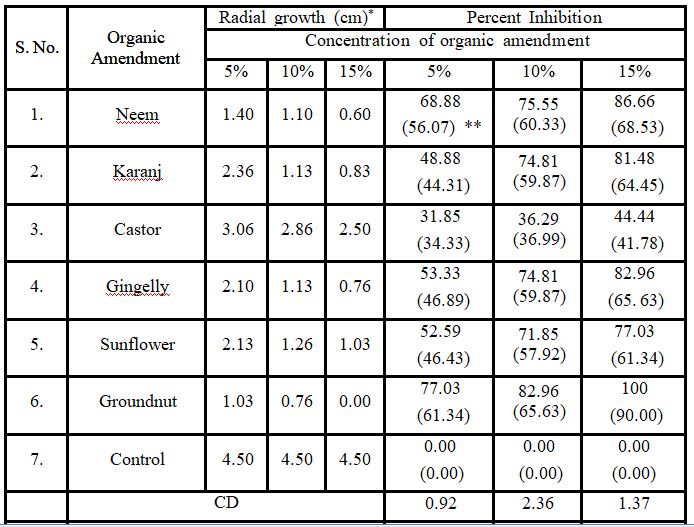
Table 2: In vitro efficacy of organic amendments on the sclerotial viability of R. solani.
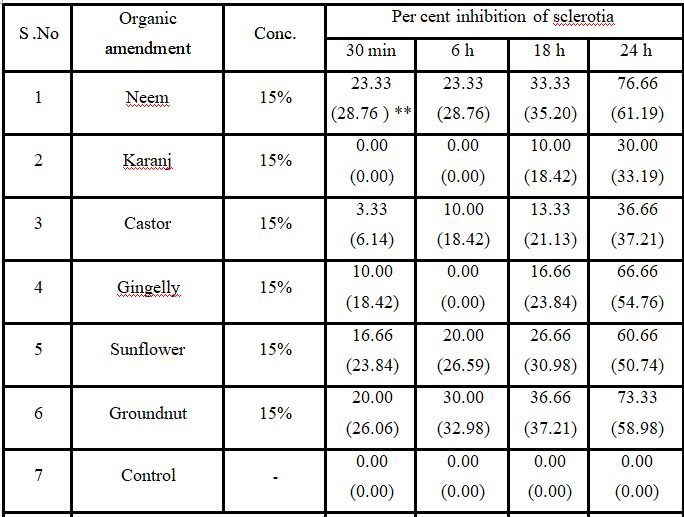

Table: 3 Efficacy of organic amendments on the sclerotial viability of R. solani in soil.
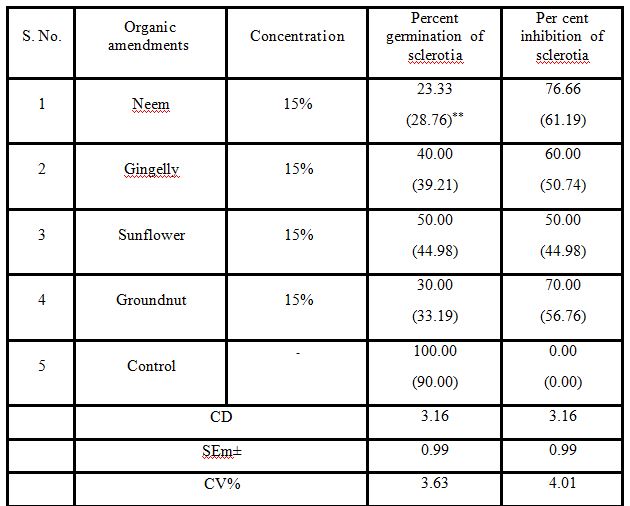
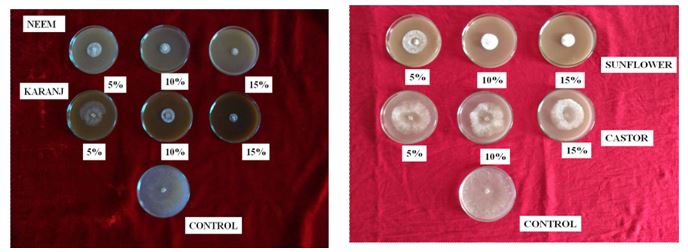
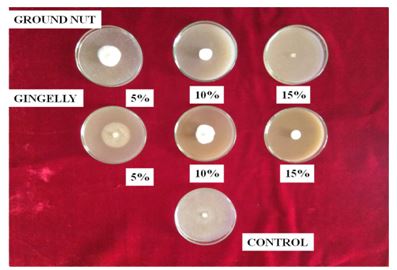
Plate 1. In vitro efficacy of organic amendments on mycelial growth of R. solani by poisoned food technique
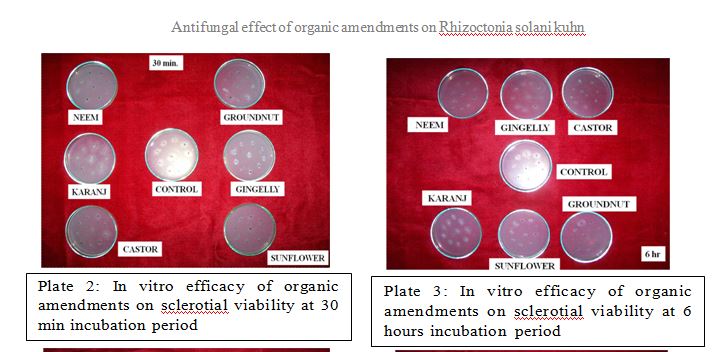
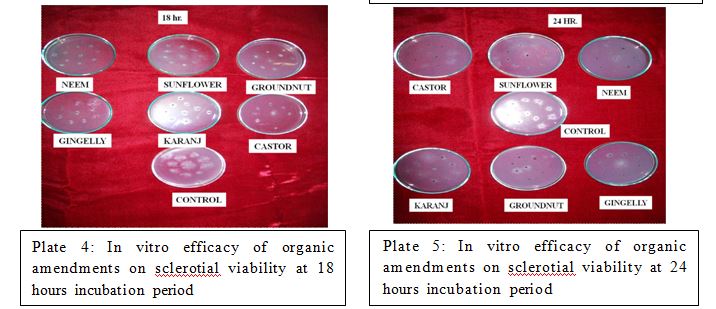

- Bio-Formulations for Plant Growth-Promoting Streptomyces SP.
- Brand Preference of Farmers for Maize Seed
- Issues That Consumer Experience Towards Online Food Delivery (Ofd) Services in Tirupati City
- Influence of High Density Planting on Yield Parameters of Super Early and Mid Early Varieties of Redgram (Cajanus Cajan (L.) Millsp.)
- Influence of Iron, Zinc and Supplemental N P K on Yield and Yield Attributes of Dry Direct Sown Rice
- Effect of Soil and Foliar Application of Nutrients on the Performance of Bold Seeded Groundnut (Arachis Hypogaea L.)

